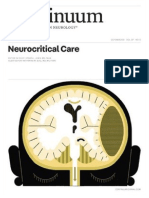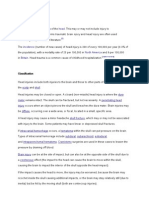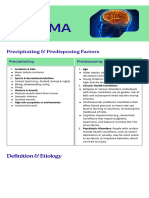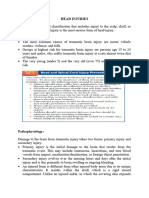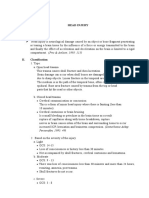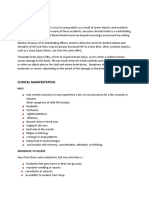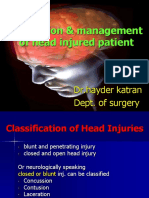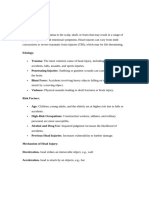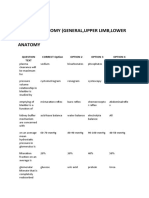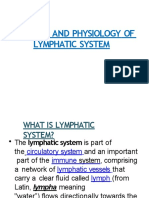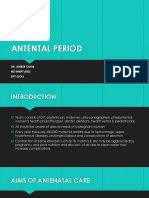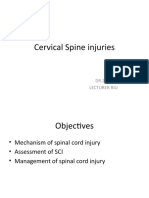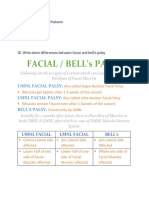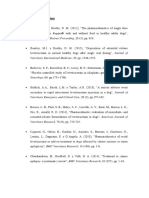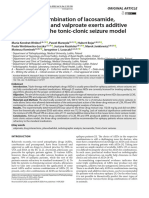100%(1)100% found this document useful (1 vote)
157 viewsHead Injury Lect 5
Head Injury Lect 5
Uploaded by
amber tariqThe document discusses various types of head injuries including coup and counter coup injuries that occur on opposite sides of the brain upon impact. It also discusses diffuse injuries like concussions and structural diffuse injuries, as well as focal injuries including subdural hematomas, epidural hematomas, and intracerebral hemorrhages. Signs and symptoms of concussions range from headaches to loss of consciousness depending on severity. Cerebral contusions can cause paralysis or altered vital signs. Epidural hematomas commonly cause a lucid interval before deterioration. Second impact syndrome occurs when a second head injury occurs before symptoms from the first have resolved.
Copyright:
© All Rights Reserved
Available Formats
Download as PPTX, PDF, TXT or read online from Scribd
Head Injury Lect 5
Head Injury Lect 5
Uploaded by
amber tariq100%(1)100% found this document useful (1 vote)
157 views27 pagesThe document discusses various types of head injuries including coup and counter coup injuries that occur on opposite sides of the brain upon impact. It also discusses diffuse injuries like concussions and structural diffuse injuries, as well as focal injuries including subdural hematomas, epidural hematomas, and intracerebral hemorrhages. Signs and symptoms of concussions range from headaches to loss of consciousness depending on severity. Cerebral contusions can cause paralysis or altered vital signs. Epidural hematomas commonly cause a lucid interval before deterioration. Second impact syndrome occurs when a second head injury occurs before symptoms from the first have resolved.
Original Title
Head Injury lect 5.pptx
Copyright
© © All Rights Reserved
Available Formats
PPTX, PDF, TXT or read online from Scribd
Share this document
Did you find this document useful?
Is this content inappropriate?
The document discusses various types of head injuries including coup and counter coup injuries that occur on opposite sides of the brain upon impact. It also discusses diffuse injuries like concussions and structural diffuse injuries, as well as focal injuries including subdural hematomas, epidural hematomas, and intracerebral hemorrhages. Signs and symptoms of concussions range from headaches to loss of consciousness depending on severity. Cerebral contusions can cause paralysis or altered vital signs. Epidural hematomas commonly cause a lucid interval before deterioration. Second impact syndrome occurs when a second head injury occurs before symptoms from the first have resolved.
Copyright:
© All Rights Reserved
Available Formats
Download as PPTX, PDF, TXT or read online from Scribd
Download as pptx, pdf, or txt
100%(1)100% found this document useful (1 vote)
157 views27 pagesHead Injury Lect 5
Head Injury Lect 5
Uploaded by
amber tariqThe document discusses various types of head injuries including coup and counter coup injuries that occur on opposite sides of the brain upon impact. It also discusses diffuse injuries like concussions and structural diffuse injuries, as well as focal injuries including subdural hematomas, epidural hematomas, and intracerebral hemorrhages. Signs and symptoms of concussions range from headaches to loss of consciousness depending on severity. Cerebral contusions can cause paralysis or altered vital signs. Epidural hematomas commonly cause a lucid interval before deterioration. Second impact syndrome occurs when a second head injury occurs before symptoms from the first have resolved.
Copyright:
© All Rights Reserved
Available Formats
Download as PPTX, PDF, TXT or read online from Scribd
Download as pptx, pdf, or txt
You are on page 1of 27
Head Injury
Pathomechanics of brain Injury
When the head strikes a fixed object, the coup injury
occurs beneath the point of cranial impact.
The counter coup injury occurs at the opposite side of
cranial impact as the brain rebounds within the
cranium.
Rotational Injury
Pathomechanics of brain Injury
Pathomechanics of brain Injury
Type of skull Fracture
Type of skull Fracture
Type of skull Fracture
Type of skull Fracture
Type of brain injuries
Diffuse brain injuries
Focal Brain injuries
Diffuse brain injuries
Structural diffuse brain injury
Cerebral concussion
Structural Diffuse Brain Injury
Structural diffuse brain injury (diffuse axonal injury, or
DAI) is the most severe type of diffuse injury because
axonal disruption occurs.
Typically resulting in disturbance of cognitive
functions, such as concentration and memory.
DAI can disrupt the brain stem centres responsible for
breathing, heart rate, and wakefulness.
Cerebral concussion or Mild diffuse injury
The most common sport-related TBI and is often
referred to as mild traumatic brain injury (MTBI).
Headache, nausea, vomiting, dizziness, balance
problems, feeling “slowed down,” fatigue, trouble
sleeping, drowsiness sensitivity to light or noise, loss
of consciousness, blurred Vision, difficulty
remembering, or difficulty concentrating.
Cerebral concussion or Mild diffuse injury
An immediate and short lived functional neurological
impairment
Concussion is most often associated with normal
results on conventional neuroimaging studies, such as
MRI or CT scan.
Type of cerebral concussion
Mild
Moderate
Severe
Types of concussion
Types of concussion
Post concussion syndrome historically called shell
shock, is a set of symptoms that may continue for
weeks, months, or occasionally a year or more after
a concussion.
“No athlete should be returned to participation while
still experiencing symptoms”
Focal Brain Injuries
1) Focal vascular Injury
Subdural hematomas
Intracerebral hemorrhages
Epidural hematomas
2) Cerebral contusions
Signs and Symptoms of Focal
Vascular Emergencies
• Loss of consciousness
• Cranial-nerve deficits
• Mental-status deterioration
• Worsening symptoms
Cerebral Contusion
The brain substance may suffer a cerebral contusion
(bruising) when an object hits the skull or vice versa.
The impact causes injured vessels to bleed internally
and there is a concomitant loss of consciousness.
Cerebral Contusion
A cerebral contusion may be associated with partial
paralysis or hemiplegia (paralysis of one side of the
body), one-sided pupil dilation, or altered vital signs
and may last for a prolonged period.
Even severe contusions recovery occurs without inter-
cranial surgery.
The prognosis is often determined by the supportive
care delivered from the moment of injury, including
adequate ventilation and cardiopulmonary
resuscitation if necessary.
Cerebral Hematoma
Epidural
Subdural
Intracerebral
Epidural
Severe blow to head; skull fracture
The epidural hematoma involves an accumulation of
blood between the dura mater and the inner surface of
the skull as a result of an arterial bleed—Middle
meningeal artery
Typically produces a skull fracture in the
temporoparietal region.
Neurological status deteriorates in 10 min–2 hr
Transport and expert evaluation
Immediate surgery may be required
Epidural
An altered state of consciousness
Lucid interval
“The problem arises when the injury leads to a slow
accumulation of blood in the epidural space, causing
the athlete to appear asymptomatic (lucid) until the
hematoma reaches a critically large size and begins to
compress the underlying brain.”
Subdural
Force of blow thrusts brain against point of impact
Subdural vessels tear and result in venous bleeding
Neurological status deteriorates in hours, days, or
weeks
Intracerebral
Depressed skull fracture, penetrating wound,
acceleration–deceleration injury
Torn artery bleeds within brain substance
A heterogenous zone of brain damage that consists of
hemorrhage, cerebral infarction, necrosis, and edema
Intracerebral hematomas are similar in
pathophysiology and imaging appearance to a cerebral
contusion.
Rapid deterioration of neurologic status
Second impact syndrome (SIS)
Sustains second injury before symptoms from first
injury resolve
Brain loses auto regulation of blood supply; rapidly
swells and herniates
Typically occurs within 1 wk of first injury
Pupils rapidly dilate, loss of eye movement,
respiratory failure, eventual coma
You might also like
- Decision Making in Adult Neurology - 2020Document391 pagesDecision Making in Adult Neurology - 2020Ahmad mughal100% (1)
- Neurocritical Care - Continuum 2021Document303 pagesNeurocritical Care - Continuum 2021Luis octavio carranza100% (1)
- Weakness AcuteDocument8 pagesWeakness AcutemgvbNo ratings yet
- STROKE: Handbook with activities, exercises and mental challengesFrom EverandSTROKE: Handbook with activities, exercises and mental challengesNo ratings yet
- 1 Medicine MCQs - CNSDocument10 pages1 Medicine MCQs - CNSDiwakesh C B88% (8)
- Acoustic NeuromaDocument14 pagesAcoustic NeuromaNeshanth SurendranNo ratings yet
- Ronny Yusyanto. Head InjuryDocument12 pagesRonny Yusyanto. Head InjuryFerdyNo ratings yet
- Headinjuries and Spinal Cord Injury LastDocument79 pagesHeadinjuries and Spinal Cord Injury LastSirat SinorNo ratings yet
- Chapter 017Document60 pagesChapter 017Jackson VonkNo ratings yet
- Head InjuryDocument13 pagesHead InjuryMay NitayakulNo ratings yet
- Ppt. Patho Head InjuryDocument56 pagesPpt. Patho Head Injurybermejomelody6877100% (3)
- 7. NeurologicTrauma (1)Document100 pages7. NeurologicTrauma (1)Temesgen ZelalemNo ratings yet
- Head InjuriesDocument76 pagesHead InjuriesWafa Nabilah Kamal100% (1)
- Head InjuryDocument11 pagesHead Injuryvirz23No ratings yet
- Head Injury NoteDocument16 pagesHead Injury NotebowbowtsbNo ratings yet
- Lec-05 Head InjuriesDocument45 pagesLec-05 Head InjuriesWafa RubabNo ratings yet
- TBI QuizletDocument4 pagesTBI QuizletLoraine CometaNo ratings yet
- Legal Head TraumaDocument7 pagesLegal Head TraumaNeil MaxiNo ratings yet
- Neurological TR 4Document4 pagesNeurological TR 4purityobotNo ratings yet
- Brain Injury: Closed (Blunt) Brain Injury Occurs When The Head Accelerates and ThenDocument7 pagesBrain Injury: Closed (Blunt) Brain Injury Occurs When The Head Accelerates and Thencute_tineeNo ratings yet
- Traumatic Brain InJuryDocument21 pagesTraumatic Brain InJuryShara SampangNo ratings yet
- Head InjuryDocument6 pagesHead Injurychuramarak23No ratings yet
- EDH - Epidural HematomaDocument5 pagesEDH - Epidural HematomaJulintari BidramnantaNo ratings yet
- Head Injury by Group 7Document36 pagesHead Injury by Group 7nishaakbar814No ratings yet
- Head InjuriesDocument26 pagesHead InjuriesCHARLOTTE DU PREEZNo ratings yet
- Management of Head Injuries (Open and ClosedDocument48 pagesManagement of Head Injuries (Open and ClosedAsmahan AliNo ratings yet
- Types of Skull FractureDocument5 pagesTypes of Skull FractureKhor Hui DiNo ratings yet
- Head Injury....Document47 pagesHead Injury....nikowareNo ratings yet
- Cerebral Concussion (Mini Case Study)Document8 pagesCerebral Concussion (Mini Case Study)Airalyn Chavez AlaroNo ratings yet
- Neurological DisordersDocument27 pagesNeurological DisordersMUHD SUHAILNo ratings yet
- Med Surg Study GuideDocument98 pagesMed Surg Study Guideprogramgrabber100% (25)
- A Traumatic Brain InjuryDocument30 pagesA Traumatic Brain Injuryhadiatarar6No ratings yet
- Head and Spinal Cord InjuryDocument57 pagesHead and Spinal Cord Injurymulugetalema240No ratings yet
- Traumatic Brain InjuryDocument50 pagesTraumatic Brain InjurySiesta CatsNo ratings yet
- Head InjuryDocument105 pagesHead Injurypuneetkumar7089No ratings yet
- Head InjuryDocument11 pagesHead InjurypertinenteNo ratings yet
- Head Injury 1Document87 pagesHead Injury 1akshay mohanNo ratings yet
- Injury of Brain and SkullDocument50 pagesInjury of Brain and SkullTselmeg TselmegNo ratings yet
- IV-14.1 Handouts - Module 11 Brain Injury-OverheadsDocument42 pagesIV-14.1 Handouts - Module 11 Brain Injury-Overheadsechika14No ratings yet
- Traumatic Brain Injury 1Document33 pagesTraumatic Brain Injury 1Bright SunshinenNo ratings yet
- ASUHAN KEPERAWATAN Head InjuryDocument26 pagesASUHAN KEPERAWATAN Head InjuryJainir RegarNo ratings yet
- Traumatic Brain-WPS OfficeDocument3 pagesTraumatic Brain-WPS OfficeHoneybill Coronas IINo ratings yet
- BRAIN INJURY - Practice TeachingDocument13 pagesBRAIN INJURY - Practice TeachingPunam PalNo ratings yet
- Head InjuryDocument10 pagesHead InjuryMelia SariNo ratings yet
- ETIOLOGY Head InjuryDocument6 pagesETIOLOGY Head InjuryCresty EstalillaNo ratings yet
- ETIOLOGY Head InjuryDocument6 pagesETIOLOGY Head InjuryCresty EstalillaNo ratings yet
- Head InjuryDocument6 pagesHead InjuryHurrinazilla AwaliaNo ratings yet
- 3 - Head Injured PatientDocument94 pages3 - Head Injured PatientAmmarNo ratings yet
- Brain InjuryDocument9 pagesBrain InjurysodumsuvidhaNo ratings yet
- Head and Spinal Cord Injury (Ci)Document111 pagesHead and Spinal Cord Injury (Ci)azmerawNo ratings yet
- Head InjuryDocument65 pagesHead Injuryanjali25sharma2003No ratings yet
- Head InjuryDocument38 pagesHead InjuryVikas SinghNo ratings yet
- Head InjuryDocument66 pagesHead Injurynur muizzah afifah hussin100% (1)
- Head InjuryDocument8 pagesHead InjuryPrem sagarNo ratings yet
- NCM 116 BaguioDocument9 pagesNCM 116 BaguioPat SubereNo ratings yet
- Birth Injuries, Head Injury and Injury To The Spinal Cord: Dr. Mehzabin AhmedDocument22 pagesBirth Injuries, Head Injury and Injury To The Spinal Cord: Dr. Mehzabin Ahmedbpt2No ratings yet
- CS Lecture1 TBI Introduction 202122 1Document68 pagesCS Lecture1 TBI Introduction 202122 1Vicky TangNo ratings yet
- How Bad Your Balance Problem Is Depends On Many FactorsDocument8 pagesHow Bad Your Balance Problem Is Depends On Many FactorsRobert Ross DulayNo ratings yet
- Head Injury - FMDocument3 pagesHead Injury - FMSivaani ChidambaramNo ratings yet
- KP 8 (Pak Zahid) Head and Neck InjuryDocument57 pagesKP 8 (Pak Zahid) Head and Neck InjurySony NugrohoNo ratings yet
- Diffuse Injury FIxDocument22 pagesDiffuse Injury FIxoomculunNo ratings yet
- How The Brain Recovers2Document94 pagesHow The Brain Recovers2Anonymous x75qV3lGNo ratings yet
- Biomechanical Basis of Traumatic Brain InjuryDocument32 pagesBiomechanical Basis of Traumatic Brain InjuryPutu AnantaNo ratings yet
- Head InjuryDocument27 pagesHead InjuryAlma SusanNo ratings yet
- TRAUMATIC BRAIN INJURYDocument83 pagesTRAUMATIC BRAIN INJURYAnna Michelle Delos ReyesNo ratings yet
- Times MS MCQSDocument10 pagesTimes MS MCQSamber tariqNo ratings yet
- MCQs OF ANATOMYDocument7 pagesMCQs OF ANATOMYamber tariqNo ratings yet
- PPR MSDocument11 pagesPPR MSamber tariqNo ratings yet
- Research Methodology MCQsDocument3 pagesResearch Methodology MCQsamber tariqNo ratings yet
- T Io NDocument37 pagesT Io Namber tariqNo ratings yet
- Anatomy and Physiology of Lymphatic SystemDocument24 pagesAnatomy and Physiology of Lymphatic Systemamber tariqNo ratings yet
- Lower ExtremityDocument39 pagesLower Extremityamber tariqNo ratings yet
- Orthopedic InjuriesDocument24 pagesOrthopedic Injuriesamber tariqNo ratings yet
- Cell & Its FunctionsDocument14 pagesCell & Its Functionsamber tariqNo ratings yet
- Tenteacher Obst - Gyn Mcqs 2nd-Ed (Shared by Ussama Maqbool)Document66 pagesTenteacher Obst - Gyn Mcqs 2nd-Ed (Shared by Ussama Maqbool)amber tariqNo ratings yet
- Spinal - Cord - Injury Lect 6Document29 pagesSpinal - Cord - Injury Lect 6amber tariqNo ratings yet
- Facial / Bell'S Palsy: Name: Sap IdDocument7 pagesFacial / Bell'S Palsy: Name: Sap IdMuhammad KaleemNo ratings yet
- Surgical Management of Traumatic Brain InjuryDocument41 pagesSurgical Management of Traumatic Brain InjuryAkreditasi Sungai AbangNo ratings yet
- Biology Investigatory Project: Topic: Parkinson'S DiseaseDocument18 pagesBiology Investigatory Project: Topic: Parkinson'S DiseaseAneesh MoosaNo ratings yet
- Precise Location of Chinese Scalp Acupuncture Areas Requires Identification of Two Imaginary Lines On The HeadDocument9 pagesPrecise Location of Chinese Scalp Acupuncture Areas Requires Identification of Two Imaginary Lines On The Headubirajara3fernandes3100% (6)
- Anatomical Diagram: Nerves in Rope BondageDocument1 pageAnatomical Diagram: Nerves in Rope BondageGabrielaNo ratings yet
- Babinski & Parachute Reflex PPT Group 3 Bsn2aDocument23 pagesBabinski & Parachute Reflex PPT Group 3 Bsn2aPaula AbadNo ratings yet
- What Is Dysphasia?Document23 pagesWhat Is Dysphasia?Nadia SultanNo ratings yet
- AtaxiaDocument10 pagesAtaxiaosakaNo ratings yet
- Parkinson Disease & Other Movement Disorders: Cherian Abraham Karunapuzha, M.DDocument40 pagesParkinson Disease & Other Movement Disorders: Cherian Abraham Karunapuzha, M.DsafiraNo ratings yet
- Hydrocephalus and Head Injury ......Document54 pagesHydrocephalus and Head Injury ......Rahul Dhaker100% (1)
- Neurological Manifestations of HIVDocument34 pagesNeurological Manifestations of HIVashuNo ratings yet
- Affiliated To CTEVT: Chabahil, KTMDocument22 pagesAffiliated To CTEVT: Chabahil, KTMBinita ShresthaNo ratings yet
- Dr. Andi Avianto Tampubolon, M.si. Med., SPS - Peripheral Nerve DisordersDocument41 pagesDr. Andi Avianto Tampubolon, M.si. Med., SPS - Peripheral Nerve DisordersFreade AkbarNo ratings yet
- Multiple-Choice Questions: I Toward Self-Assessment CME. Category 1 CME Credits Not DesigDocument9 pagesMultiple-Choice Questions: I Toward Self-Assessment CME. Category 1 CME Credits Not DesigManish MauryaNo ratings yet
- Cefepime-Induced NeurotoxicityDocument1 pageCefepime-Induced NeurotoxicityPetrosNo ratings yet
- Self Care DeficitDocument3 pagesSelf Care DeficitAddie Labitad100% (2)
- ACVIM Forum Abstract Proceeding, 26 (3), Pp. 819.: Bibliografía LevetiracetamDocument4 pagesACVIM Forum Abstract Proceeding, 26 (3), Pp. 819.: Bibliografía LevetiracetamjuanNo ratings yet
- Glass Coma ScaleDocument3 pagesGlass Coma ScaleRnspeakcomNo ratings yet
- Bab 7Document27 pagesBab 7bangarudaugtherNo ratings yet
- Lewis 10th Edition Neurological Chapter Highlights 55-60Document5 pagesLewis 10th Edition Neurological Chapter Highlights 55-60watchNo ratings yet
- Abnormal PosturingDocument3 pagesAbnormal PosturingJoão PedroNo ratings yet
- Antiepilepticsnaser 160502063005Document30 pagesAntiepilepticsnaser 160502063005Vivek PandeyNo ratings yet
- Multiple SclerosisDocument3 pagesMultiple SclerosisCarmella CollantesNo ratings yet
- Ukg Asahan - ExcelDocument124 pagesUkg Asahan - ExcelSutantoNo ratings yet
- Three - Drug Combination ofDocument5 pagesThree - Drug Combination ofNaji Z. ArandiNo ratings yet

